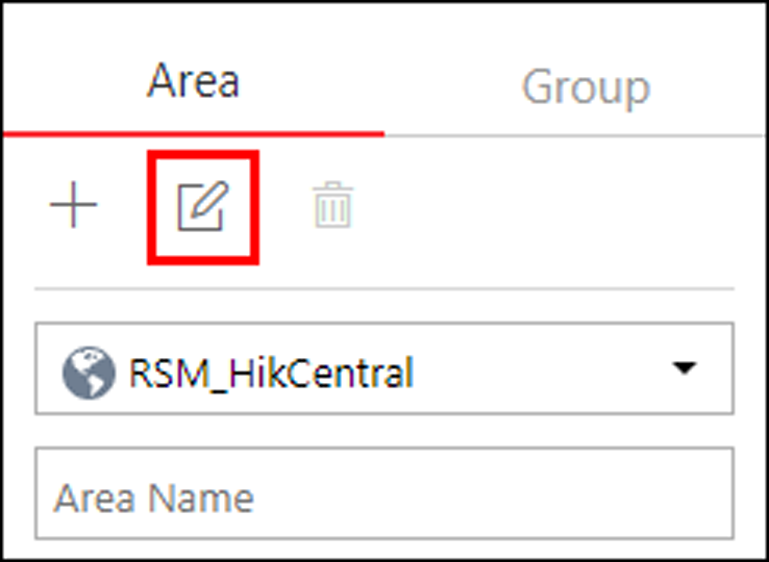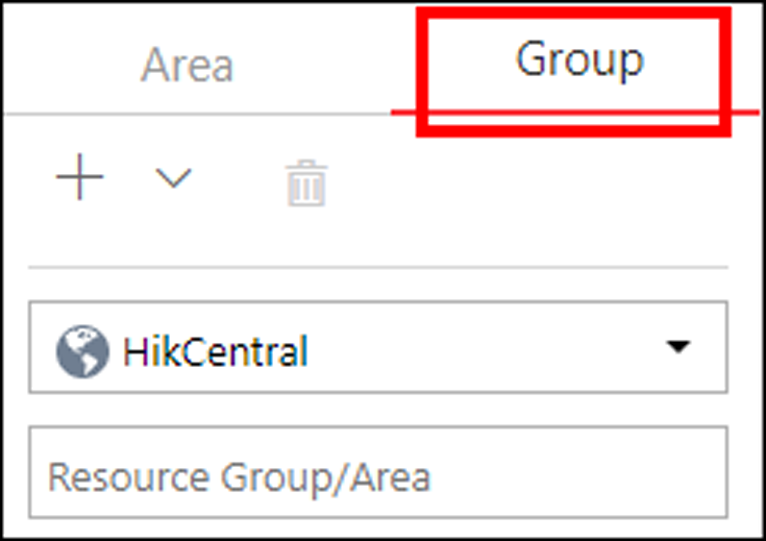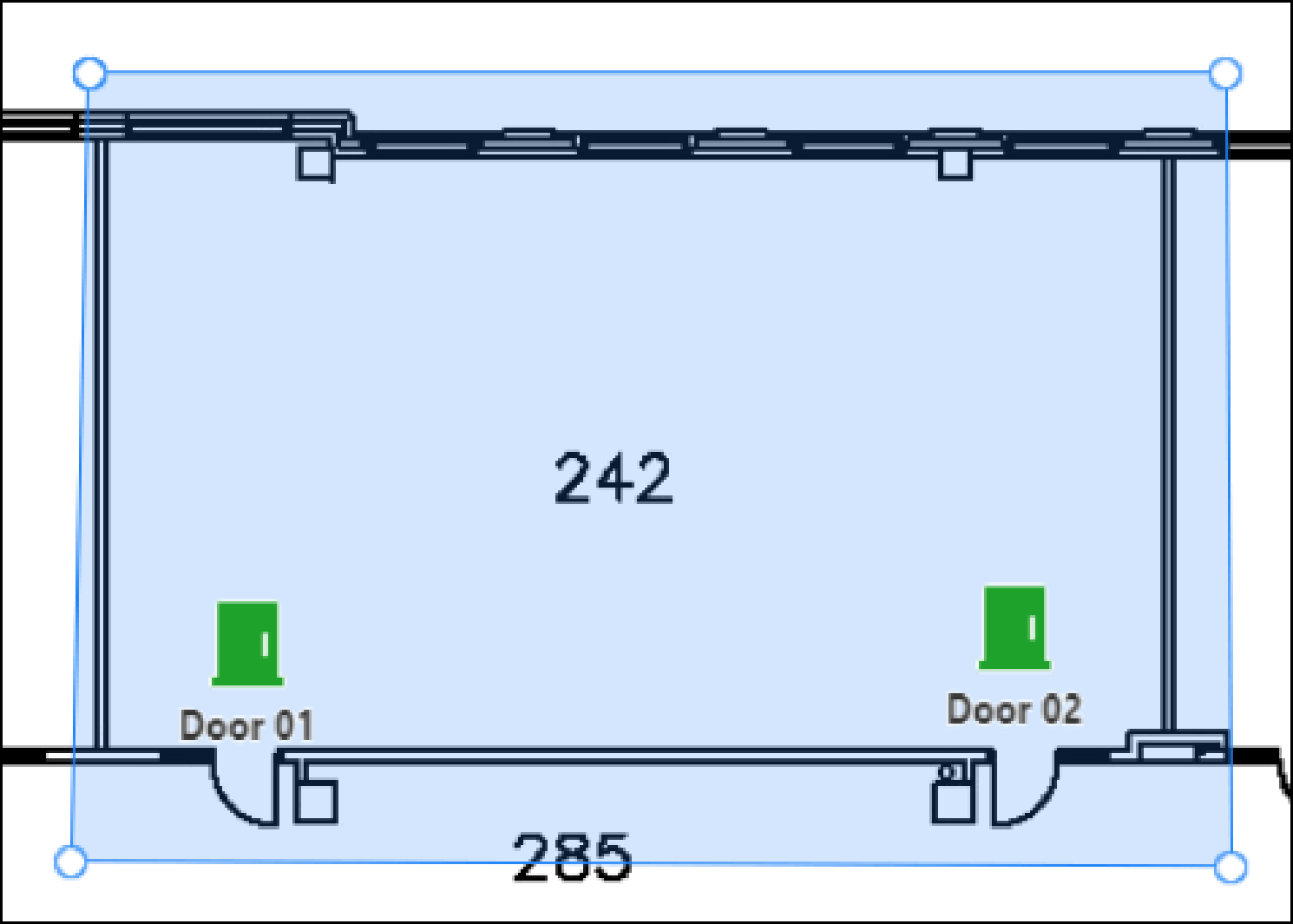Configure Multi-Door Interlocking
Multi-door interlocking is used to control the entry of persons to a secure area such as a clean room, where dust or small particles may be a problem. One multi-door interlocking group is composed of at least two doors and only one door can be opened simultaneously.
Add the access points into different areas first. For details, refer to Add Element to Area.
- Click Logical View on the home page.
-
Choose one of the following methods to enter the area's resource group
page.
-
Select one area and click
 to enter the editing
area page.Figure 1. Enter Area Editing Page
to enter the editing
area page.Figure 1. Enter Area Editing Page
-
Select Group tab on the left to display all the resource groups of different areas.
Figure 2. Enter Resource Group Page
-
-
In the Multi-Door Interlocking field, click Add to add a
multi-door interlocking group.
Figure 3. Add Multi-Door Interlocking Group

- Create a name for the group.
- In the Door field, click Add to select the doors to add them to the group. Among the added doors, only one door can be opened simultaneously.
- Optional:
You can locate the multi-door interlocking group on the map by setting the
locations of the doors in the group and setting the border of the region for
detection.
-
Check Add to Map.
The region as well as the doors in the group will be added to the map of the area on the right.
- Drag to draw the region according to the actual needs.
- Drag the icons of the doors to set the their locations on the map.
-
Right click to finish.
Figure 4. Draw Multi-Door Interlocking Group on Map

After adding the multi-door interlocking group on the map, when multi-door interlocking alarm is triggered by the doors in the group, the client will notify the user by highlighting the region on the map and you can view the real-time alarms triggered in the region in the Monitoring module on the Control Client.
-
Check Add to Map.
-
Click Add.
The multi-door interlocking group is added in the table and you can view the doors in the group.
- Legal Information
- Symbol Conventions
- About Web Client
- Login
- Download Mobile Client
- Web Control
- Manage License
- Manage Resource
- Create Password for Inactive Device(s)
- Edit Online Device's Network Information
- Manage Encoding Device
- Add Detected Online Device
- Add Encoding Device by IP Address or Domain Name
- Add Encoding Devices by IP Segment
- Add Encoding Devices by Port Segment
- Add Encoding Device by Hik-Connect DDNS
- Add Encoding Device by Device ID
- Add Encoding Devices by Device ID Segment
- Add Encoding Devices in a Batch
- Limit Bandwidth for Video Downloading
- Set N+1 Hot Spare for NVR
- Network Transmission Device Management
- Upgrade Device Firmware
- Restore/Reset Device Password
- Manage Remote Site
- Manage Application Data Server
- Manage Recording Server
- Manage Streaming Server
- Manage DeepinMind Server
- Add Security Audit Server
- Manage Smart Wall
- Manage Area
- Add Area
- Add Element to Area
- Edit Element in Area
- Edit Camera for Current Site
- Configure Visual Tracking
- Configure Smart Linkage
- Edit Door for Current Site
- Edit Elevator for Current Site
- Edit Radar for Current Site
- Edit Alarm Input for Current Site
- Edit Alarm Output for Current Site
- Edit Under Vehicle Surveillance System for Current Site
- Edit Third-Party Integrated Resource for Current Site
- Edit Element for Remote Site
- Remove Element from Area
- Manage Resource Group
- Configure Recording
- Configure Event and Alarm
- Manage Map
- Manage Person List
- Manage Visitor
- Manage Access Control and Elevator Control
- Flow Chart
- Manage Access Control Device
- Manage Elevator Control Device
- Manage Access Level
- Access Control Test
- Advanced Functions
- Manage Video Intercom
- Flow Chart
- Manage Video Intercom Device
- Batch Link Persons with Indoor Station
- Relate Doorbell with Indoor Station
- Configure Device Parameters
- Manage Time and Attendance
- Flow Chart
- Add Attendance Group
- Add Timetable
- Add Shift Schedule
- Assign Shift Schedule to Attendance Group
- Configure Attendance Parameters
- Manage Attendance Record
- Search Attendance Record
- Correct Attendance Record for Single Person
- Correct Check-In/Out for Multiple Persons
- Apply for Leave for Single Person
- Apply for Leave for Multiple Persons
- Manually Calculate Attendance Results
- Export Attendance Records
- Get Attendance Records from Device
- View Attendance Handling Records
- Configure Attendance Report
- Manage Entrance and Exit
- Manage Facial Comparison
- Dock Station
- Manage Security Control
- Manage Security Control Device
- Add Detected Online Device
- Add Security Control Device by IP Address
- Add Security Control Device by Hik-Connect DDNS
- Add Security Control Devices by IP Segment
- Add Security Control Devices by Port Segment
- Add Security Control Device by Device ID
- Add Security Control Device by Device ID Segment
- Add Security Control Devices in a Batch
- Add Security Control Partitions from Device
- Configure Defense Schedule Template
- Manage Security Control Device
- Manage Role and User
- Maintenance
- Manage System Security
- System Configuration
- Set Site Name
- Set User Preference
- Set Warning Threshold for Server Usage
- Set Printer
- Set NTP
- Set Active Directory
- Enable Receiving Generic Event
- Allow for Remote Site Registration
- Register to Central System
- Device Access Protocol
- Set WAN Access
- Set Network Timeout
- Set Device Access Mode
- Set IP Address for Receiving Device Information
- Set Data Retention Period
- Set Holiday
- Set Email Template
- Send Report Regularly
- Enable Evidence Collection
- Set Transfer Protocol
- Set Camera ID
- Export Service Component Certificate
- Set Database Password
- Set Health Check Frequency
- Add Fuzzy Matching Rules for License Plate Search
- Configure System Hot Spare
- Set Third-Party Integration
- Data Interchange
- Reset Device Network Information
- Set SUP Upgrade Prompt
- Monitoring
- Intelligent Analysis Report
- Skin-surface Temperature
- Important Ports
Configure Multi-Door Interlocking
Multi-door interlocking is used to control the entry of persons to a secure area such as a clean room, where dust or small particles may be a problem. One multi-door interlocking group is composed of at least two doors and only one door can be opened simultaneously.
Add the access points into different areas first. For details, refer to Add Element to Area.
- Click Logical View on the home page.
-
Choose one of the following methods to enter the area's resource group
page.
-
Select one area and click
 to enter the editing
area page.Figure 1. Enter Area Editing Page
to enter the editing
area page.Figure 1. Enter Area Editing Page
-
Select Group tab on the left to display all the resource groups of different areas.
Figure 2. Enter Resource Group Page
-
-
In the Multi-Door Interlocking field, click Add to add a
multi-door interlocking group.
Figure 3. Add Multi-Door Interlocking Group

- Create a name for the group.
- In the Door field, click Add to select the doors to add them to the group. Among the added doors, only one door can be opened simultaneously.
- Optional:
You can locate the multi-door interlocking group on the map by setting the
locations of the doors in the group and setting the border of the region for
detection.
-
Check Add to Map.
The region as well as the doors in the group will be added to the map of the area on the right.
- Drag to draw the region according to the actual needs.
- Drag the icons of the doors to set the their locations on the map.
-
Right click to finish.
Figure 4. Draw Multi-Door Interlocking Group on Map

After adding the multi-door interlocking group on the map, when multi-door interlocking alarm is triggered by the doors in the group, the client will notify the user by highlighting the region on the map and you can view the real-time alarms triggered in the region in the Monitoring module on the Control Client.
-
Check Add to Map.
-
Click Add.
The multi-door interlocking group is added in the table and you can view the doors in the group.